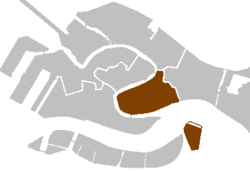This article needs additional citations for verification .(November 2025) |

San Marco is one of the six sestieri of Venice, lying in the heart of the city as the main place of Venice. [1] San Marco also includes the island of San Giorgio Maggiore. [2] Although the district includes Saint Mark's Square, that was never administered as part of the sestiere.

